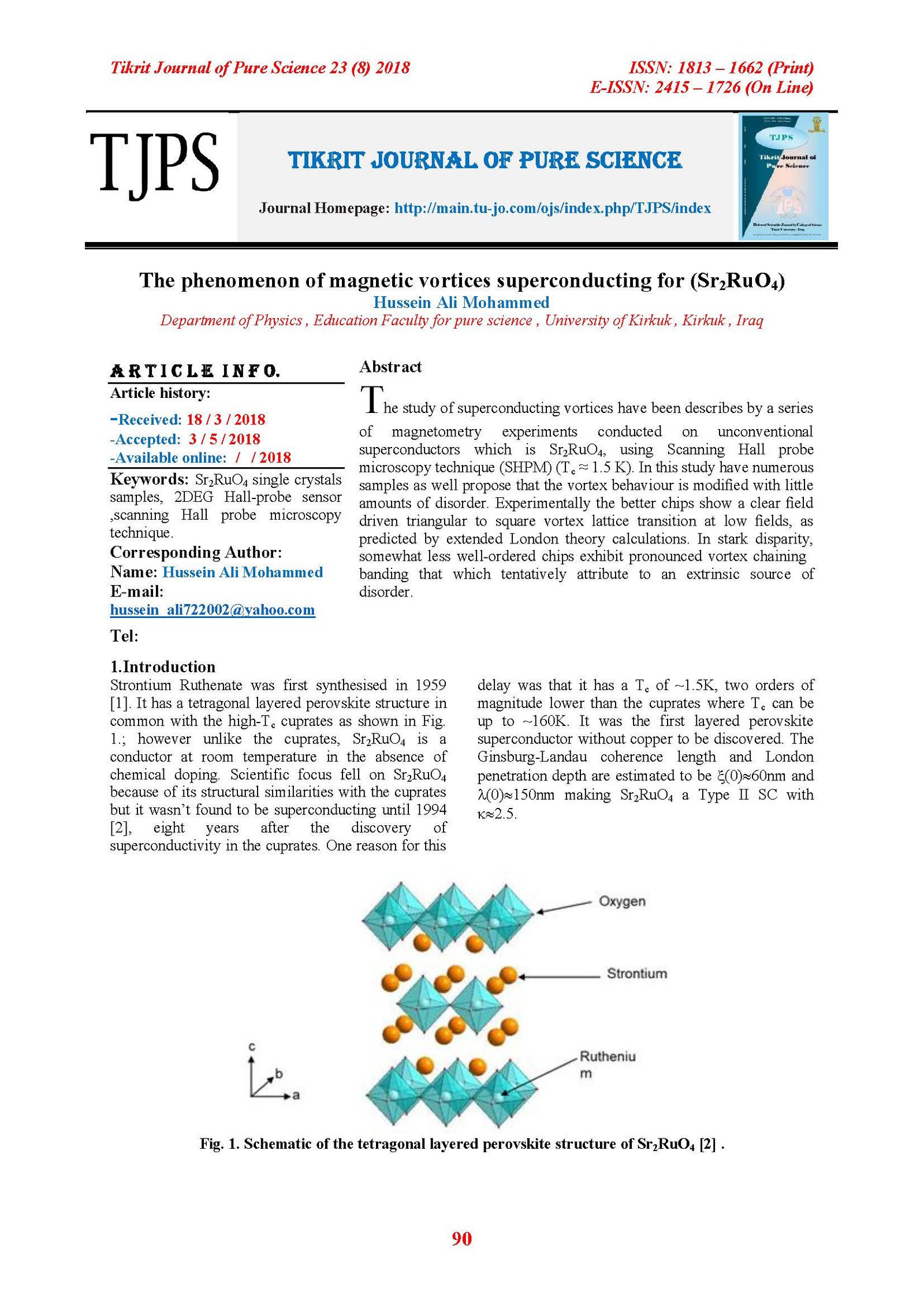The phenomenon of magnetic vortices superconducting for (Sr2RuO4)
Main Article Content
Abstract
The study of superconducting vortices have been describes by a series of magnetometry experiments conducted on unconventional superconductors which is Sr2RuO4, using Scanning Hall probe microscopy technique (SHPM) (Tc ≈ 1.5 K). In this study have numerous samples as well propose that the vortex behaviour is modified with little amounts of disorder. Experimentally the better chips show a clear field driven triangular to square vortex lattice transition at low fields, as predicted by extended London theory calculations. In stark disparity, somewhat less well-ordered chips exhibit pronounced vortex chaining banding that which tentatively attribute to an extrinsic source of disorder.
Article Details

This work is licensed under a Creative Commons Attribution 4.0 International License.
Tikrit Journal of Pure Science is licensed under the Creative Commons Attribution 4.0 International License, which allows users to copy, create extracts, abstracts, and new works from the article, alter and revise the article, and make commercial use of the article (including reuse and/or resale of the article by commercial entities), provided the user gives appropriate credit (with a link to the formal publication through the relevant DOI), provides a link to the license, indicates if changes were made, and the licensor is not represented as endorsing the use made of the work. The authors hold the copyright for their published work on the Tikrit J. Pure Sci. website, while Tikrit J. Pure Sci. is responsible for appreciate citation of their work, which is released under CC-BY-4.0, enabling the unrestricted use, distribution, and reproduction of an article in any medium, provided that the original work is properly cited.
References
[1] Xia, J.; Yoshiteru, M.; Beyersdorf, P. T.; Fejer, M. M.and Kapitulnik, A. (2006). High resolution polar Kerr effect measurements of Sr2RuO4: Evidence for broken time-reversal symmetry in the superconducting state. Physical Review Letters, 97 (16):167002.
[2] Wang, H. et al. (2017). Probing chiral superconductivity in Sr2RuO4 underneath the surface by point contact measurements. New Journal of Physics, 19:053001.
[3] Bending, J. (2012).Vortex Imaging in a Superconductors. Physica C: Superconductivity, 479:65-68.
[4] Dolocan, V.O.; Lejaya, P.; Mailly, D. and Hasselbach, K. (2006). Observation of two species of vortices in the anisotropic spin-triplet superconductor Sr2RuO4. Physical Review. B , 74 (14):144505.
[5] Björnsson, P.G.; Maeno, Y.; Martin and Moler, K. A. (2005). Scanning magnetic imaging of Sr2 Ru O4. Physical Review B, 72 (1):012504.
[6] Catherine, K. (2012). Chiral p-wave order in Sr2RuO4. .IOP Publishing Ltd, 75 (4).
[7] Kallin, C. and Berlinsky, A. J. (2009). Is Sr2RuO4 a Chiral P-Wave Superconductor . Journal of Physics: Condensed Matter, 21 (16):164210.
[8] Bending, S.J. (1999). Local magnetic probes of superconductors. Advances in Physics, 48 (4):449-535.
[9] Mao, Z.; Maenoab, Y. and Fukazawa, H. (2000). Crystal growth of Sr2RuO4. Materials Research Bulletin, 35 (11):1813-1824.
[10] Kohno, W.; Ueki,H. and Kita, T. (2016) . Hall Effect in the Abrikosov Lattice of Type-II Superconductors, Journal of the Physical Society of Japan, 85 ( 8).
[11] Chen, C.J. (1993). Introduction to scanning tunneling microscopy. 1st ed., Oxford University Press, New York.
[12] Khomenko, D.; L'vov, V.S.; Pomyalov, A. and Procaccia, I. (2018). Dynamics of the vortex line density in superfluid counterflow turbulence. Physical Review. B, 97:014508.
[13] Marchiori, E., Curran, P.J.; Kim J.; Satchell, N.; Burnell, G. and Bending, S.J. (2017). Reconfigurable superconducting vortex pinning potential for magnetic disks in hybrid structures. Scientific Reports, 7:45182.
[14] Lichtenberg,F. (2002). The story of Sr2RuO4. Progress in Solid State Chemistry, 30 :103–131.
[15] LIO, Y. and Mao, Z. (2015). Unconventional superconductivity in Sr2RuO4. Physica C: Supercondicivity and its Applications, 514:339-353.
